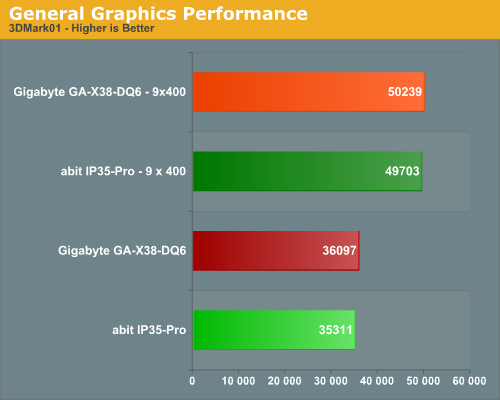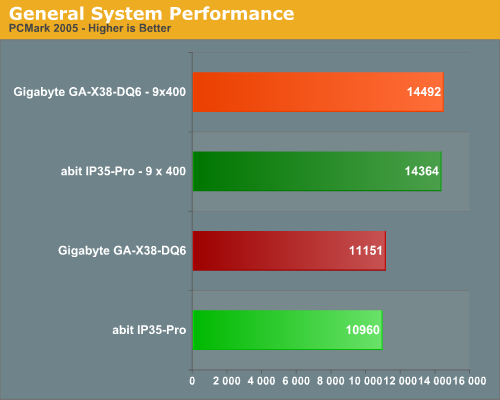Gigabyte GA-X38-DQ6: An early look at X38
by Gary Key on September 4, 2007 3:00 AM EST- Posted in
- Motherboards
Synthetic Graphics Performance
The 3DMark series of benchmarks developed and provided by Futuremark are among the most widely used tools for benchmark reporting and comparisons. Although the benchmarks are very useful for providing apple to apple comparisons across a broad array of GPU and CPU configurations they are not a substitute for actual application and gaming benchmarks. In this sense we consider the 3DMark benchmarks to be purely synthetic in nature but still valuable for providing consistent measurements of performance.


In our 3DMark06 test, the X38 and P35 are basically even in this test. The Gigabyte board is around 2% faster when overclocked although this margin is still relatively small. When looking at the individual tests, the Gigabyte board scored slightly better in the SM2.0 and SM3.0 tests while the CPU scores were just about identical when comparing the two chipsets.
In the more memory and CPU throughput sensitive 3DMark01 benchmark we see our Gigabyte GA-X38-DQ6 board about 2% quicker at stock speeds and only 1% when overclocked. The differences in performance are not really noticeable in either 3DMark unless you're looking to reach the top of the ORB, which we have a good feeling the X38 was designed to do with the right setup.
General System Performance
The PCMark05 benchmark developed and provided by Futuremark is designed to measure overall system performance for the typical home computing user. This tool provides both system and component level benchmarking results utilizing subsets of real world applications or programs. This benchmark is useful for providing comparative results across a broad array of Graphics, CPU, Hard Disk, and Memory configurations along with multithreading results. In this sense we consider the PCMark benchmark to be both synthetic and real world in nature and it again provides consistency in our benchmark results.

Our PCMark05 scores mimic the results from our 3DMark benchmarks with differences of around 2% at stock speeds and 1% when overclocked. While this benchmark is designed around actual application usage, we will see if these results mirror our own real-world application testing.
The 3DMark series of benchmarks developed and provided by Futuremark are among the most widely used tools for benchmark reporting and comparisons. Although the benchmarks are very useful for providing apple to apple comparisons across a broad array of GPU and CPU configurations they are not a substitute for actual application and gaming benchmarks. In this sense we consider the 3DMark benchmarks to be purely synthetic in nature but still valuable for providing consistent measurements of performance.


In our 3DMark06 test, the X38 and P35 are basically even in this test. The Gigabyte board is around 2% faster when overclocked although this margin is still relatively small. When looking at the individual tests, the Gigabyte board scored slightly better in the SM2.0 and SM3.0 tests while the CPU scores were just about identical when comparing the two chipsets.
In the more memory and CPU throughput sensitive 3DMark01 benchmark we see our Gigabyte GA-X38-DQ6 board about 2% quicker at stock speeds and only 1% when overclocked. The differences in performance are not really noticeable in either 3DMark unless you're looking to reach the top of the ORB, which we have a good feeling the X38 was designed to do with the right setup.
General System Performance
The PCMark05 benchmark developed and provided by Futuremark is designed to measure overall system performance for the typical home computing user. This tool provides both system and component level benchmarking results utilizing subsets of real world applications or programs. This benchmark is useful for providing comparative results across a broad array of Graphics, CPU, Hard Disk, and Memory configurations along with multithreading results. In this sense we consider the PCMark benchmark to be both synthetic and real world in nature and it again provides consistency in our benchmark results.

Our PCMark05 scores mimic the results from our 3DMark benchmarks with differences of around 2% at stock speeds and 1% when overclocked. While this benchmark is designed around actual application usage, we will see if these results mirror our own real-world application testing.










26 Comments
View All Comments
jay401 - Tuesday, September 4, 2007 - link
How does it compare to the previous gen motherboards almost everyone is running?Is it really worth an upgrade from 650i/680i/P965/975X?
That's really what matters.
TA152H - Tuesday, September 4, 2007 - link
The chart "Media encoding - Sony Vegas" makes no sense. I think you got the stock performances twisted.Also three to five percent over the P35 sounds incredible, as in not credible. Especially with the Penryn (with it's bigger cache). When the motherboard makers talk this, you should try to find out what processor they are talking about. Maybe on a 512K processor it can reach it, but on a 4 MB processor, on most benchmarks, it doesn't sound realistic at all. Well, it also depends what they are comparing it to. It says the P35, but maybe they meant the 975X, which is much more likely. Crossfire, of course, will be much higher, but how many people are actually using this? It's a very, very low percentage. So, I think people are going to be disappointed again, like they were with the Penryn, because of misguided expectations. Penryn, like x38, is a great product, it's a shame people lose that because of these unrealistic expectations. Still, anything is possible, but if it averages 4% on most applications against the P35, on a Penryn (will enthusiasists buy the Conroe when it comes out?), I'd be very surprised.
One suggestion, when you do the final review, run it with a Conroe-L as well. Why would an enthusiast site run this as well? Well, if I needed a machine, right now (as in I had one computer and it died), I would buy it for $40 and then buy a Penryn when it became available, or cheap, and then use it in a low power computer. You might see the 3-5% claim have a chance on a small cache processor. That's probably what they were talking about, without actually wanting to say it.
phusg - Tuesday, September 4, 2007 - link
Sounds an interesting upgrade path. But aren't Conroe-L's the Celeron 4xx's which are socket 478? Do we even know what socket Penryn will be?
TA152H - Tuesday, September 4, 2007 - link
Conroe-L is LGA 775, same as Penryn will be. I suspect almost any motherboard being made now will work with the Penryn, or whatever the desktop version is called, really. I can't keep up with these stupid names AMD and Intel come up with for their processors. The ass that thought of Barcelona should be sterilized. What an absurd name. If they had any brains they might make code names and add something like -L for light, -M for mobile, -S for server, -QM for Quad Mobile, etc...Instead, they have these horrendous code names, which are suitably replaced by horrendous model numbers. I really can't keep track. Pentium III 1 GHz was so much easier to remember.
Guuts - Tuesday, September 4, 2007 - link
Gary,Page 2: Third paragraph from the bottom, should have (DDR2-1066) and not (DDR-1066).
Page 3: Missing graphic at the top of the page, text starting off with "memory-lg.png memory-sm.png" is probably the cause?
Page 5: Chart 2 (Sony Vegas) either has the stock speed bars' labels reversed, or your text summary is incorrect, as the chart doesn't show the Gigabyte board ahead in both stock and overclocked speeds.
Page 7: Second paragraph, last sentence, "...better than several retails boards" should just be "retail".
Good article overall, though I was expecting a bit more of an improvement over the P35. I bet there will be a nice boost over the 975X when we see the full review, however. Thanks for the early look, Gary.
Now...where is the P35 board roundup? :-p
JarredWalton - Tuesday, September 4, 2007 - link
Hi - sorry about the graph missing... that was my mistake. You can blame me for a few other missed typos as well if you'd like. I'm not sure on the Sony Vegas chart if there's some sort of labeling error or if we need to correct the text, so I'm leaving it alone.--Jarred